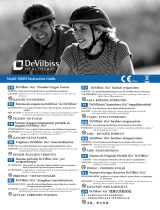
LT-2023
15
COMPRESSOR
The DeVilbiss Oxygen Concentrator uses a double-head, oil-free
compressor. The compressor is secured to the base with four motor
mounts.
A compressor that is worn or defective may:
• causepressuretoriseslowly.
• causeexcessivenoiseand/orvibration.
• causeloweroxygenconcentrations.
A worn or defective compressor can be caused by a defective internal
component such as:
• reedvalve
• o-ring
• gasket
• cupseal
These components are included in the Compressor Rebuild Kit (part
#525DZ-643).
NOTE– A built-in thermal cutoff switch will shut the compressor off if it
becomes overheated. This protects the compressor from
damage caused by heat build-up. (Some models have an
auxiliary thermostat mounted within the compressor
compartment.)
NOTE–Apressurerelief(PR)valveislocatedonthepressureheadto
prevent high pressure build up in the system should a
component malfunction occur.
To test the compressor operating voltage (Fig 11):
The compressor requires line voltage to operate. If the compressor does
not start when the unit is turned on, the voltage input must be tested:
1. This voltage can be checked at the compressor connector using a
voltmeter or test light connected to the brown and blue wires. The
voltmeter is the best way to test.
2. If no voltage is detected, disconnect power and check for loose or
broken wires between the compressor connector and switch or
wire harness.
3. If there is voltage at the compressor connector, then either the
capacitor or the compressor itself is defective.
To test the compressor for proper output:
NOTE– If the compressor is not providing a high enough
output the patient alert system may be activated.
1. Remove the front and back cabinets.
2. Connect pressure-vacuum gauges to the sieve bed test points. See
the Sieve Bed Pressure Test in the Component Testing, Repair, and
Replacement section for details on attaching the gauge. A defective
compressor will be indicated by slowly rising pressure. Pressure may
only reach a certain level and then stop.
If these conditions are observed then:
• Theunitlter(s)maybeoccluded—checktheairlter,compressor
filter, and intake filter for occlusions.
• Theremaybeasevereleakinthesystem—checkforairleaksusing
a leak detection solution such as Snoop® or equivalent (must not
contain ethylene glycol).
CAUTION– Do not apply leak test solution to any part of the rotary
valve or the main PC Board assembly.
• Thecompressorreedvalves,cupseal,orthecompressoritselfmay
be defective.
If the filters are not occluded and no leaks are found, the compressor
must then be removed and repaired or replaced.
To remove the compressor:
1. Make sure the unit is unplugged from the wall outlet.
2. Disconnect the compressor wires by disconnecting the compressor
electrical connector (Figure 11).
3. Remove the ladder clamp and hose from the exhaust fittings on the
compressor head (Figure 12) and compressor filter.
4. Carefully place the concentrator on its front side. From the bottom
of the unit, remove the four 10 mm hex nuts that secure the motor
mounts.
5. Lift compressor partially out of the compressor housing area and
loosen ladder clamp securing hose to the intake fitting, then remove
hose.
6. Compressor may now be removed from the compressor housing
area.
CAUTION– If the unit has been running recently, the compressor
may be hot.
7. Unscrew motor mounts from compressor feet by hand.
To inspect and/or replace internal components
(Figs. 15 & 15A):
1. Remove the eight screws that hold the compressor heads in place.
When removing the heads, be sure to keep each head and its
components with the correct compressor side.
2. Check for proper placement of or damage to the gaskets on the
bottom of the compressor heads. Replace if damaged.
3. Remove reed valve plates. A reed valve is located on each side of the
valve plate.
4. The compressor reed valves should be flush with the valve plate. If
the valve is broken or not flush with the valve plate, or foreign
matter is detected inside the head, clean or replace the compressor
reed valves.
To replace the compressor reed valves (Fig. 15A):
a. Remove the screw holding the compressor reed valves in
position on the valve plate and discard the used reed valves.
b. Position the new reed valves so that they are centered and
completely cover the holes in the valve plate.
c. Place the metal retainer on the reed valves and secure with the
reed valve screw.
5. Check for proper placement of or damage to the rubber o-ring on
the bottom of the valve plate. Replace if damaged.
6. Remove piston sleeves by pulling upward and inspect cup seal on
pistons. Replace if badly worn or damaged.
To replace cup seal (Fig. 15A):
a. Remove rod screw from top of piston.
b. Remove the cup retainer plate.
c. Discard defective cup seal.
d. Place new cup seal into position.
e. Replace cup retainer plate.
f. Secure with screws.
7. Reposition sleeve on piston.
NOTE– In some cases, it may be easier to position sleeve on piston
before installing a new cup seal and retainer plate.
COMPONENT TESTING, REPAIR, AND REPLACEMENT




























